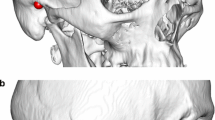Abstract
In neurosurgery, cranial incisions during craniotomy can be recovered by cranioplasty—a surgical operation using cranial implants to repair skull defects. However, surgeons often encounter difficulties when grafting prefabricated cranial plates into defective areas, since a perfect match to the cranial incision is difficult to achieve. Previous studies using mirroring technique, surface interpolation, or deformed template had limitations in skull reconstruction to match the patient’s original appearance. For this study, we utilized low-resolution and high-resolution computed tomography images from the patient to repair skull defects, whilst preserving the original shape. Since the accuracy of skull reconstruction was associated with the partial volume effects in the low-resolution images and the percentage of the skull defect in the high-resolution images, the low-resolution images with intact skull were resampled and thresholded followed by active contour model to suppress partial volume artifacts. The resulting low-resolution images were registered with the high-resolution ones, which exhibited different percentages of cranial defect, to extract the incised cranial part. Finally, mesh smoothing refined the three-dimensional model of the cranial defect. Simulation results indicate that the reconstruction was 93.94% accurate for a 20% skull material removal, and 97.76% accurate for 40% skull material removal. Experimental results demonstrate that the proposed algorithm effectively creates a customized implant, which can readily be used in cranioplasty.







Similar content being viewed by others
References
Adams R, Bischof L (1994) Seeded region growing. IEEE Trans Pattern Anal Mach Intell 16:641–647
Besl PJ, Mckay ND (1992) A method for registration of 3-D shapes. IEEE Trans Pattern Anal Mach Intell 14:239–256
Borgefors G (1988) Hierarchical chamfer matching: a parametric edge matching algorithm. IEEE Trans Pattern Anal Mach Intell 10:849–865
Carr JC, Fright WR, Beatson RK (1997) Surface interpolation with radial basis functions for medical imaging. IEEE Trans Med Imaging 16:96–107
Chong CS, Lee HP, Kumar AS (2006) Automatic hole repairing for cranioplasty using Bezier surface approximation. J Craniofac Surg 17:344–352
Cohen LD (1991) On active contour models and balloons. CVGIP: Image Underst 53:211–218
Dean D, Min K-J (2003) Deformable templates for preoperative computer-aided design and fabrication of large cranial implants. Int Congr Ser 1256:710–715
Hartkens T, Hill DLG, Castellano-Smith AD, Hawkes DJ, Maurer CR, Martin AJ, Hall WA, Liu H, Truwit CL (2003) Measurement and analysis of brain deformation during neurosurgery. IEEE Trans Med Imaging 22:82–92
Hill DLG, Batchelor PG, Holden M, Hawkes DJ (2001) Medical image registration. Phys Med Biol 46:R1–R45
Hutchinson P, Timofeev I, Kirkpatrick P (2007) Surgery for brain edema. Neurosurg Focus 22:E14
Kass M, Witkin A, Terzopoulos D (1987) Snakes: active contour models. Int J Comput Vis 1:321–331
Kozerke S, Botnar R, Oyre S, Scheidegger MB, Pedersen EM, Boesiger P (1999) Automatic vessel segmentation using active contours in cine phase contrast flow measurements. J Magn Reson Imaging 10:41–51
Lee M-Y, Chang C-C, Lin C-C, Lo L-J, Chen Y-R (2002) Custom implant design for patients with cranial defects. IEEE Eng Med Biol 21:38–44
Lee S-C, Wu C-T, Lee S-T, Chen P-J (2009) Cranioplasty using polymethyl methacrylate prostheses. J Clin Neurosci 16:56–63
Liao Y-L, Sun Y-N, Lu C-F, Wu Y-T, Wu C-T, Lee S-T, Lee J-D (2010) Skull-based registration of intra-subject CT images: the effects of different resolutions and partial contents. In: Mahadevan V, Zhou J (eds) Proceeding of the 2nd International Conference on Bioinformatics and Biomedical Technology (ICBBT), Research Publishing Services, Singapore, pp 269–272
Lorensen WE, Cline HE (1987) Marching cubes: a high resolution 3D surface construction algorithm. ACM SIGGRAPH Comput Graph 21:163–169
Maes F, Collignon A, Vandermeulen D, Marchal G, Suetens P (1997) Multimodality image registration by maximization of mutual information. IEEE Trans Med Imaging 16:187–198
Manawadu D, Quateen A, Findlay JM (2008) Hemicraniectomy for massive middle cerebral artery infarction: a review. Can J Neurol Sci 35:544–550
Maravelakis E, David K, Antoniadis A, Manios A, Bilalis N, Papaharilaou Y (2008) Reverse engineering techniques for cranioplasty: a case study. J Med Eng Technol 32:115–121
Ohtake Y, Belyaev A, Bogaevski I (2001) Mesh regularization and adaptive smoothing. Comput Aided Design 33:789–800
Pelizzari CA, Chen GTY, Spelbring DR, Weichselbaum RR, Chen CT (1989) Accurate three-dimensional registration of CT, PET, and/or MR images of the brain. J Comput Assist Tomogr 13:20–26
Press WH (1992) Numerical recipes in C: the art of scientific computing. Cambridge University Press, Cambridge/New York
Roche A, Malandain G, Pennec X, Ayache N (1998) The correlation ratio as a new similarity measure for multimodal image registration. In: Wells WM, Colchester A, Delp S (eds) 1st International Conference on Medical Image Computing and Computer Assisted Intervention (MICCAI), LNCS 1496, Springer, Berlin/Heidelberg, pp 1115–1124
Schirmer CM, Ackil AA, Malek AM (2008) Decompressive craniectomy. Neurocrit Care 8:456–470
Sommer HJ, Eckhardt RB, Shiang TY (2006) Superquadric modeling of cranial and cerebral shape and asymmetry. Am J Phys Anthropol 129:189–195
Subramaniam S, Hill MD (2009) Decompressive hemicraniectomy for malignant middle cerebral artery infarction: an update. Neurologist 15:178–184
Wu T, Engelhardt M, Fieten L, Popovic A, Radermacher K (2006) Anatomically constrained deformation for design of cranial implant: methodology and validation. In: Larsen R, Nielsen M, Sporring J (eds) 9th International Conference on Medical Image Computing and Computer Assisted Intervention (MICCAI), LNCS 4190, Springer, Berlin/Heidelberg, pp 9–16
Wu WZ, Zhang Y, Li H, Wang WS (2009) Fabrication of repairing skull bone defects based on the rapid prototyping. J Bioact Compat Polym 24:125–136
Yushkevich PA, Piven J, Hazlett HC, Smith RG, Ho S, Gee JC, Gerig G (2006) User-guided 3D active contour segmentation of anatomical structures: significantly improved efficiency and reliability. Neuroimage 31:1116–1128
Acknowledgments
The authors express appreciation to Kevin Fortune for his assistance in English language editing. This work is funded by the Department of Industrial Technology of Ministry of Economic Affairs, Taiwan, under the contract numbers 97-EC-17-A-19-S1-035 and 98-EC-17-A-19-S1-035.
Author information
Authors and Affiliations
Corresponding author
Rights and permissions
About this article
Cite this article
Liao, YL., Lu, CF., Sun, YN. et al. Three-dimensional reconstruction of cranial defect using active contour model and image registration. Med Biol Eng Comput 49, 203–211 (2011). https://doi.org/10.1007/s11517-010-0720-0
Received:
Accepted:
Published:
Issue Date:
DOI: https://doi.org/10.1007/s11517-010-0720-0




